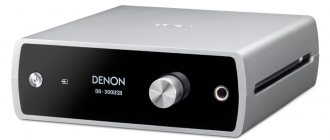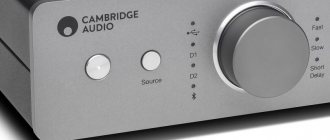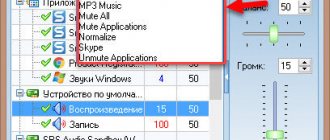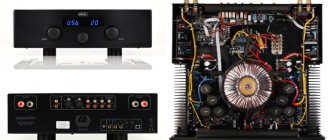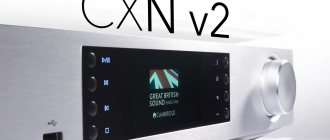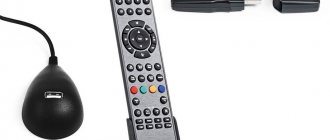Description of the external DAC Cambridge Audio DacMagic XS V2
Cambridge Audio has given its popular DacMagic XS portable DAC/headphone amplifier a minor cosmetic upgrade. The updated model with the V2 index received a new version of the logo and the ability to choose one of five available color options for the case (titanium, red, gold, blue and black). The functionality and audio characteristics remain unchanged. To convert the digital signal to analog, the ESS9023 chip (24 bit/192 kHz) is used. This DAC will be an excellent option for improving the sound of a computer/laptop with a built-in sound card, the power of which is 10 times less than the amplifier installed in the Cambridge Audio DacMagic XS V2.
The neat rectangular mini-casing of the Cambridge Audio DacMagic XS V2 DAC is made of aluminum, and its weight does not exceed 100 g. The components of the model are reliably protected from all kinds of external interference. A micro USB port with the ability to switch to asynchronous mode is built into one of the ends of the DAC. On the opposite side is a 3.5mm jack that can be used as a headphone jack or a regular line-out. The top cover of the model includes two large buttons with minus and plus signs, which are used to change the volume level (53-step control). Simultaneously pressing and holding these buttons for 5 seconds. switches the USB port from normal mode (specification 1.0) to asynchronous mode (specification 2.0), when used, it becomes possible to work with files in 24-bit/192 kHz resolution. For PCs with Windows, installation of the appropriate driver is required. For Apple computers, driver installation is not required. When the maximum volume is reached, the LED indicator located next to the 3.5 mm output begins to flicker. When receiving a signal with a sampling frequency of 44.1 or 48 kHz, the LED lights up blue, at 88.2 or 96 kHz - green, and at a frequency of 176.4/192 kHz - red. At minimum volume, the indicator also begins to blink, but its color depends on the sampling frequency of the received signal. The DAC receives power from the computer via the USB port.
The Cambridge Audio DacMagic XS V2 external DAC provides more natural, detailed and dense sound compared to the sound of a standard computer or laptop sound card. The model is distinguished by the correct tonal balance and fast, well-developed low frequencies.
Portable DAC review: Hi-Fi for the long haul
Audioengine D3
The D3's aluminum body, assembled with tiny screws, feels very durable and resists any attempt to bend it.
Turning what at first glance seems like a simple USB flash drive into a nice-looking hi-fi component is no easy task, but Audioengine has managed to do it. Thanks to its small aluminum body, Audioengine is very similar to a flash drive - to complete the picture, only a cap is missing
It's a shame, however, that it doesn't come with the same aluminum cover to protect the USB connector when it's not plugged in or in your pocket. However, the D3 is equipped with its own woolen case - so at least the DAC will be warm in the long cold winter.
In addition, the kit includes a short but clear installation guide and a cable with an adapter that will allow you to connect headphones with a 6.3 mm plug to the 3.5 mm output. We tested the D3 with AKG K550 over-ear headphones and Klipsch X7i in-ear headphones.
HD audio support
The Audioengine DAC is compatible with Mac and Windows computers; unlike some other models, it does not require an additional driver for Windows. Like AudioQuest DragonFly v1.2, the D3 accepts files up to 24-bit/96 kHz “as is”; High-resolution formats with 24-bit/192 kHz sampling will have to be pre-encoded by the computer to 24/96. The D3 also allows asynchronous data transfer from a computer's USB output for improved sound quality.
There are two tiny indicators on the front of the device. The outermost one glows blue if Audioengine is processing recordings with a sampling rate of 88.2 kHz or higher; otherwise it remains dark. The near white LED indicates that the DAC is turned on and ready to receive data.
Unlike the Cambridge Audio DacMagic XS, the D3 is not equipped with a volume control - as is the AudioQuest DragonFly v1.2. You will have to control it using a program that plays music.
Detail and strength
D3 manages to extract a decent amount of detail from a WAV copy of Eminem's Bad Guy. The device prefers direct, unsophisticated sound. The dark bass notes strike with sufficient force; The claps scattered throughout the song are delivered precisely and clearly - although the emotion of Eminem's voice is not recreated as convincingly as AudioQuest.
We would have liked more fine detail and a more complete development of note textures. The lack of sophistication of the sound slightly reduces the joy of listening.
Lily Allen's Christmas cover of "Somewhere Only We Know" shows the focus and expressiveness of the singer's graceful piano work and soft voice, but the overall sound is less natural and authentic than the DacMagic XS. In addition, it is inferior to that of DragonFly in the quality of conveying the subtlest nuances and emotional content of the song.
Audioengine's design isn't bad, but it fails to fully capture the listener's attention and leave a lasting impression. And considering the price – not the lowest among the test models – the D3 doesn’t have too many chances.
Price: $250
Grade: 3
PROS: Pleasant, weighty sound; workmanship; good detail
CONS: The sound lacks clarity, detail and dynamics; price
VERDICT: The sound is generally not bad, but competitors have it better and the price is lower
Figures and facts
- Add. inputs:No
- Outputs: 3.5mm
- Max. Sampling:24bit/96kHz
- Dimensions (H×W×D):6.5×2×1 cm
AudioQuest DragonFly v1.2
When it was introduced in 2012, the DragonFly made a splash. AudioQuest has taken two traditional hi-fi components - a DAC and a headphone amplifier - and combined them into a convenient, compact package with excellent sound.
Externally, the new model is indistinguishable from the first, although in fact it is DragonFly v1.2. The difference can be detected by the sticker on the case, as well as by the color of the ring around the headphone output (it used to be black, now it is grey). In addition, there are several new lettering and logos.
However, a lot has changed inside. In an effort to further improve audio quality, the company has shortened the signal path between the DAC chip and the analog output, and also redesigned the internal power supply.
The list of DragonFly stats has not changed; it's still asynchronous, compatible with PC and Mac, and volume control will have to be done on the playback device. Files with sampling rates up to 24-bit/96 kHz DragonFly are played “as is,” while high-resolution formats with 24-bit/192 kHz parameters have to be re-encoded by the computer to 24/96.
Color coding
We've always really liked the design and construction of the DragonFly; it has a solid weight to it, and the matte black finish is very nice to the touch. The logo lights up in different colors to match the characteristics of the files being played: green - 44.1 kHz, cyan - 48 kHz, amber - 88.2 kHz, and magenta - 96 kHz.
Just listen to a couple of songs and you will see that the openness, spaciousness and detail of the sound of the first version of DragonFly is fully preserved, but it has acquired additional purity.
The new DragonFly reveals even more detail and is equipped with increased dynamic power. The performance is closer to the original than before.
"Up Is Down" from the Pirates of the Caribbean soundtrack has a big sound - powerful, rhythmic and dynamic - and DragonFly easily conveys all these qualities to the listener. In the WAV version of this composition, the strings exhibit a natural fluidity, and the horns combine with percussion to create a dynamic, explosive finale.
Luxurious tempo and rhythm
DragonFly boasts impeccable rhythm and accurate transmission of tempo rhythms. Calvin Harris's upbeat dance tune "Under Control" showcases groovy enthusiasm and an equally upbeat tempo; Listening to it instantly improves your mood.
LFs delight with density and depth; this is highlighted by rapper Jay-Z's confident and compelling performance of Empire State Of Mind - both in a CD-quality copy and streaming from Spotify. The drums hit sharply and powerfully, their attack clearly defined, as are the piano notes in the background. Alicia Keys' voice comes out a little less soft than in the Cambridge Audio version, but the transparency and detail are higher in the DragonFly.
The best thing about this is the combination of amazing sound quality with a truly tempting price. DragonFly's successful flight continues!
Price: $350
Grade: 5
PROS: Incredibly clear and detailed sound; luxurious dynamics; amazing rhythm; spectacular design;
CONS: For this price - nothing
VERDICT: The first version was wonderful, but the quality of the new one is even higher
Figures and facts
- Add. inputs:No.
- Outputs: 3.5mm
- Max. Sampling:24bit/96kHz
- Dimensions (H×W×D):6.2×1.9×2.1 cm
Cambridge Audio DacMagic XS
Cambridge Audio already has two excellent DACs - DacMagic 100 and DacMagic Plus; however, they are both fairly large desktop devices that are mains powered. The ultra-portable DacMagic XS is miniature and USB powered.
Don't judge the size by the photo; in life DacMagic XS is much smaller: 5 cm high, 3 cm wide, 1 cm deep
This is one of the most inexpensive components in its class, but you can’t tell this from the appearance of the DacMagic XS: a stylish compact case, a pleasant finish. It is slightly wider and thicker than the DragonFly and Audioengine models, but the build quality is very high; This DAC makes a very good impression.
There are few connectors here: only a microUSB input on one end, which is used to connect to a computer using the supplied cable, and a standard 3.5 mm headphone output on the other.
A single LED indicates the sampling rate of the input signal: when receiving files with a frequency of 44.1 bit/48 kHz it glows blue, with 88.2/96 it glows green, and with 176.4/192 it glows purple. It also shows the volume level.
Very easy to use
If when playing music through AudioQuest and Audioengine DACs, the volume has to be controlled from the computer, then Cambridge Audio has its own controls - round “+” and “–” buttons. If you press both at once and hold for a few seconds, they switch the DAC from USB 1.0 to USB 2.0 mode. In the second case, DacMagic XS is capable of receiving a stream in the original high resolution - 24 bit/192 kHz. USB 1.0 mode is limited to 24 bit/96 kHz (PC users need to download the driver from the Cambridge website for this).
USB 2.0 mode has another advantage: the sound quality in this case is usually higher. Even a standard 16-bit/44.1 kHz CD copy of Lady Gaga's "Do What You Want" performs better in USB 2.0 mode: more focused, stable and confident, with lots of finely organized detail.
The Cambridge DAC imparts pleasant weight and energetic dynamics to the composition; Precise, agile and well-developed bass forms its foundation. DacMagic's pleasant tonal character helps soften the sound of overly harsh or bright recordings. If you're used to listening to music from your laptop or desktop computer through the headphone output, you'll instantly feel the difference with DacMagic.
Soft, full-blooded sound
Higher resolution files are even more pleasing to the ear. Kate Bush's 50 Words For Snow at 24/96 sounds sophisticated and intricate; Cambridge demonstrates enviable meticulousness and special care in recreating vocals, which are characterized by natural warmth and fullness. The recording of Beethoven's Piano Concerto No. 4 in G Minor Op.58 is no less admirable.
However, it seems to us that the AudioQuest DragonFly has a slightly clearer sound, as well as slightly higher detail and quality of dynamics.
The Cambridge Audio DAC easily beats out competitors from Fiio and Audioengine; its main problem is the AudioQuest DragonFly with its new ultra-low price. It costs just $150 more, and many buyers will pay a little extra for a significant increase in sound quality.
Price: $200
Grade: 4
PROS: Excellent tonal character; pleasant sound; support for 24/192 formats; quality of finish
CONS: Detail and dynamics are not ideal
VERDICT: DacMagic XS is very good and perfect for those who can't afford to spend more
Figures and facts
- Add. Inputs:Micro USB
- Outputs: 3.5mm
- Max. Sampling:24bit/192kHz
- Dimensions (H×W×D):5.4×3×1 cm
- Weight:100g
Fiio E17
Externally, the Fiio E17 looks more like an MP3 player than a compact headphone amplifier with a DAC. However, it is portable enough to carry in your pocket and is generally in the same class as the DragonFly and D3 models.
Having a screen is good; a device with a display is much more convenient on the road, as well as during initial setup
Lots of features
The E17 immediately scores a few points thanks to its very high level of equipment for this price category. Firstly, it has a small OLED display. Whereas on other devices in this class, sampling rate data is limited to (often incomprehensible) color coding and miniature LEDs, here you can simply look at the display - at the same time specifying the name of the song.
The mini-USB port for connecting to a computer's USB port operates according to the USB 1.0 standard, so the Fiio is capable of receiving streams up to 24-bit/96 kHz. Files in 24/192 format can be fed through the dedicated digital input E17 using a coaxial cable and the included adapter. The optical input is only compatible with 96 kHz.
In addition, you can also receive a signal from another source, such as a CD player, using the Fiio's built-in DAC, and then send it to an amplifier or a pair of powered speakers.
Speaking of amplifiers, on the bottom edge of the E17 there is a special connector for connecting to the Fiio E09K desktop amplifier. A 3.5mm input for a smartphone or MP3 player allows the Fiio to be used as a headphone amplifier.
A CD copy of the song La La La by Naughty Boy with 16/44 sampling is perceived as high quality and convincing; Fiio's pleasant tonal character is more soothing than aggressive.
When listening through the AKG K550 headphones, the strings sound soulful and delicate, and the bass is quite energetic, allowing them to convey the cheerful tempo of the music.
The higher sample rate version of the Rolling Stones' Gimme Shelter shows a noticeable increase in detail, and the Fiio copes well with the increased resolution. Keith Richards' guitar solo is heard quite sharply and clearly, although it is inferior in dynamics and emotionality to the DragonFly and DacMagic XS models.
Not the most transparent sound
We would also like greater clarity of reproduction: while the DragonFly reveals the composition, giving it volume, transparency and detail, then the E17 is meticulous enough to give the listener a general idea of the music - but it cannot convey the subtlest nuances that make the performance exciting. strength.
The sound gets better after setting the volume on the E17 to maximum, and on the source (MacBook Pro) to a slightly lower level. The result is increased volume and improved dynamics, but not enough to disturb the class leaders.
The composition Royals by singer Lorde is performed well, but the bass lacks a little power and purpose. Fiio fails to recreate the dynamics and scale of a recording as fully as, for example, DragonFly.
In theory, Fiio is quite good; the list of its functions and characteristics can impress fans of good sound. However, the sound quality is noticeably inferior to its closest competitors. It is acceptable - and nothing more.
Price: $225
Grade: 3
PROS: Pleasant, non-aggressive sound; balance and detail; equipment
CONS: The sound isn't the most energetic or exciting; lacks transparency and depth of elaboration
VERDICT : E17 is universal and versatile, but in terms of quality it is far from the leaders
Figures and facts
- Add. inputs: 3.5 mm, optical/coaxial digital, mini USB
- Outputs: 3.5mm
- Max. Sampling:24bit/192kHz
- Dimensions (H×W×D):9.6×5.5×1.5 cm
- Weight:112 g
Let's sum it up
Winner AudioQuest DragonFly $350
The new version of DragonFly costs a third less than the first, and sounds even better; It seems to us that today competitors simply have nothing to oppose
The cute and compact AudioQuest DragonFly DAC with excellent sound flies to success on the wings of the wind.
We feel a little sorry for the Cambridge Audio DacMagicXS, which lost its fifth star as a result of the collision with the winner; If you can spend $200 and not a cent more, the DacMagicXS is a pretty good option, with high quality build quality and unusually refined sound for its price range.
But the difference in cost with the AudioQuest DAC is not that great, but in quality it is definitely much greater. The new version of DragonFly v1.2 is even better than its excellent predecessor.
With a noticeable reduction in price, sound quality has increased to the same extent; the music delights with its extraordinary purity and amazing detail, and the dynamic capabilities of the DragonFly cannot be compared with any model in this class.
Fiio E17 performed quite well. It is slightly larger than its competitors, but is equipped with additional and very useful functions. Its sound is more cautious than exciting; we would have liked more richness and spiciness - but we shouldn't judge too harshly, given the price and equipment.
And finally, Audioengine D3. The sound quality is roughly the same as the Fiio: quite good, but not amazing. With a rather inexpressive sound, this is the most expensive model in the test; so we were forced to give it only a C.
BEFORE THE PURCHASE
File Permission
It's easy to get confused by the technical specifications. Many of the test participants accept formats with sampling up to 24 bit/96 kHz via USB, but do not support 24/192. How important this is to you depends on your collection. If you buy tracks on iTunes or rip them from a CD without compression, then 96 kHz is more than enough for you. If you prefer the highest resolution recordings, make sure your DAC understands them.
COMPLETE THE SYSTEM
This couple will help DragonFly's talents to fully reveal themselves
Laptop
Apple MacBook Pro from $1200
We love the ease of use of the MacBook Pro and the convenient interface for storing music.
Headphones
Philips Fidelio M1 $250
Warm and natural sound with an amazing amount of detail.
Characteristics of the external DAC Cambridge Audio DacMagic XS V2
| DAC | ESS9023 chip (24 bit/192 kHz) |
| Supported sampling rate | USB 1.0 mode: 16/24 bit, 44.1, 48, 88.2 and 96 kHz; USB 2.0 mode: 16/24 bit, 44.1, 48, 88.2, 96, 176.4 and 192 kHz |
| Frequency range | 20 Hz – 20 kHz (±0.2 dB) |
| Output voltage | 2 V |
| Output impedance | 0.5 ohm |
| Maximum output power | 150 mW |
| Harmonic Distortion Factor | less than 0.004% |
| Signal to noise ratio | 103 dB |
| Crosstalk | 66 dB |
| Minimum headphone impedance | 12 ohm |
| Number of volume adjustment steps | 53 steps (54 different volume levels) |
| Inputs | micro USB with two operating modes: USB 1.0 (24 bit/96 kHz) and asynchronous USB 2.0 (24 bit/192 kHz) |
| Exits | linear 3.5 mm |
| Fabric carrying bag | There is |
| Dimensions (WxHxD) | 30x10x54 mm |
| Weight | 100 g |
